
Welcome to toledosnakes.com! I am David, a snake enthusiast living in Toledo, OH. Many people don't know that Toledo is in fact full of snakes! You just need to know where to find them - they can often be shy and elusive. Some Ohio snake species are more common outside of the city limits, in different parts of Lucas County OH, but many types of snakes are indeed common in the more urban parts of Toledo. This guide is meant to help educate you about the beautiful snakes of Toledo, and to help you identify the most common snakes of Toledo, as well as the venomous snakes of Toledo that you should learn to recognize and avoid. If you want more detail, click here for my complete list of ALL snake species in Toledo. Remember the following:
- Most snakes of Toledo are harmless and don't want to encounter you
- Venomous snakes exist but are uncommon in Toledo, Ohio
- Snakes eat rats and mice and are a valuable part of the Ohio ecosystem
- Never kill a snake - if you leave a snake alone, it will leave you alone.
Common Snake Species in Toledo
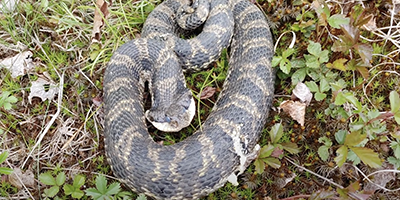 Eastern Hog-nosed Snake:
The eastern hog-nosed snake is usually gray or yellow-brown in color. They also tend to have black or dark brown splotches around their bodies. These types of snakes are located in the south, central region, and northwest of Ohio. These snakes can grow up to 18-30 inches. Their favorite and most eaten food are toads, but they also have a diet of frogs, salamanders, birds, mammals, and invertebrates. Interestingly, when they are cornered, they will suck in the air, spread their skin like a cobra, hiss, and then pretend to strike. They will also play dead, sometimes opening their mouth and rolling on their back. These habits are all for show and hog-nosed snakes rarely bite pets or humans.
Eastern Hog-nosed Snake:
The eastern hog-nosed snake is usually gray or yellow-brown in color. They also tend to have black or dark brown splotches around their bodies. These types of snakes are located in the south, central region, and northwest of Ohio. These snakes can grow up to 18-30 inches. Their favorite and most eaten food are toads, but they also have a diet of frogs, salamanders, birds, mammals, and invertebrates. Interestingly, when they are cornered, they will suck in the air, spread their skin like a cobra, hiss, and then pretend to strike. They will also play dead, sometimes opening their mouth and rolling on their back. These habits are all for show and hog-nosed snakes rarely bite pets or humans.
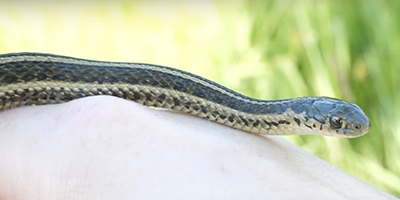 Butler’s Garter Snake:
This garter snake is usually brown or black in color, and they usually have black or yellow stripes on their sides. They are located in the northwestern parts of Ohio, and are very secretive, preferring to stay underground and will only go out to sun themselves when digesting. These snakes have a tendency to grow to about 15-20 inches. Their diet consists mainly of earthworms, but they will also eat leeches, salamanders, and small frogs. These snakes are very docile and shy, and they will always choose to flee the scene when approached. They rarely bite, but they will if provoked. They are nonvenomous.
Butler’s Garter Snake:
This garter snake is usually brown or black in color, and they usually have black or yellow stripes on their sides. They are located in the northwestern parts of Ohio, and are very secretive, preferring to stay underground and will only go out to sun themselves when digesting. These snakes have a tendency to grow to about 15-20 inches. Their diet consists mainly of earthworms, but they will also eat leeches, salamanders, and small frogs. These snakes are very docile and shy, and they will always choose to flee the scene when approached. They rarely bite, but they will if provoked. They are nonvenomous.
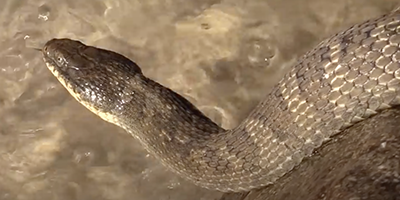 Lake Erie Water Snake:
Lake Erie water snakes are usually gray, green, and brown. Their bellies are white in color, but some variants may sometimes have a pink tinge in the middle of their bodies. As stated with its name, these snakes are found on the Islands of Lake Erie in Ohio. These snakes can grow up to 24-42 inches long. They mainly eat amphibians and fishes in Lake Erie, but their favorite food is the round goby, which is an invasive fish. They are listed as endangered because of their declining numbers due to loss of habitat, so killing them would be illegal under Ohio’s state law.
Lake Erie Water Snake:
Lake Erie water snakes are usually gray, green, and brown. Their bellies are white in color, but some variants may sometimes have a pink tinge in the middle of their bodies. As stated with its name, these snakes are found on the Islands of Lake Erie in Ohio. These snakes can grow up to 24-42 inches long. They mainly eat amphibians and fishes in Lake Erie, but their favorite food is the round goby, which is an invasive fish. They are listed as endangered because of their declining numbers due to loss of habitat, so killing them would be illegal under Ohio’s state law.
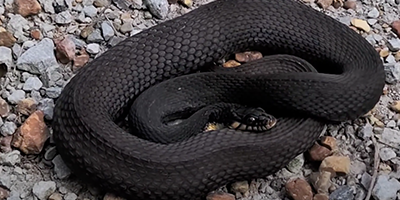 Copperbelly Water Snake:
These water snakes are usually black or dark brown in color, and as their name suggests, their bellies tend to be orange or red. These types of snakes can be found in Ohio, southern Michigan, and northern Indiana, and are possibly found in the areas around those locations. These snakes can grow up to 24-42 inches in length, and their diet mostly consists of frogs, tadpoles, and other amphibians. Their preferred habitat is places that are permanently wet, such as ditches, sloughs, and shallow wetlands near areas of larger and deeper wetlands, because shallow water enables them to hunt for their prey faster and more efficiently. They are also listed as threatened and are protected under the Endangered Species Act.
Copperbelly Water Snake:
These water snakes are usually black or dark brown in color, and as their name suggests, their bellies tend to be orange or red. These types of snakes can be found in Ohio, southern Michigan, and northern Indiana, and are possibly found in the areas around those locations. These snakes can grow up to 24-42 inches in length, and their diet mostly consists of frogs, tadpoles, and other amphibians. Their preferred habitat is places that are permanently wet, such as ditches, sloughs, and shallow wetlands near areas of larger and deeper wetlands, because shallow water enables them to hunt for their prey faster and more efficiently. They are also listed as threatened and are protected under the Endangered Species Act.
Venomous Snake Species in Toledo
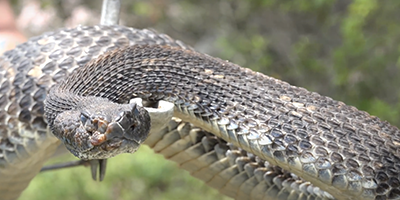 Eastern Timber Rattlesnake:
The eastern timber rattlesnake is usually yellow or black in color. The yellow variants have dark brown or black chevron-shaped lines around their body, the lines are yellowish in color. The black variants have the same lines and shapes but are black in color. These snakes are found in the northwest of Ohio. The Ohio Department of Natural Resources considers this snake to be one of the most dangerous snakes in northeastern America due to its size; they are also counted as an endangered species. They can grow to about 6 feet in length.
Eastern Timber Rattlesnake:
The eastern timber rattlesnake is usually yellow or black in color. The yellow variants have dark brown or black chevron-shaped lines around their body, the lines are yellowish in color. The black variants have the same lines and shapes but are black in color. These snakes are found in the northwest of Ohio. The Ohio Department of Natural Resources considers this snake to be one of the most dangerous snakes in northeastern America due to its size; they are also counted as an endangered species. They can grow to about 6 feet in length.
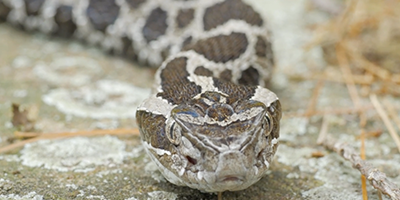 Eastern Massasauga Rattlesnake:
The eastern massasauga rattlesnake is usually gray or brownish-gray in color, they also have about 29-50 spots around its body. These snakes are considered by the Ohio Department of National Resources to be endangered and are now also considered to be rare in North America. These snakes have also been reportedly seen in about 22 counties all around Ohio. These snakes can grow up to 14-25 inches.
Eastern Massasauga Rattlesnake:
The eastern massasauga rattlesnake is usually gray or brownish-gray in color, they also have about 29-50 spots around its body. These snakes are considered by the Ohio Department of National Resources to be endangered and are now also considered to be rare in North America. These snakes have also been reportedly seen in about 22 counties all around Ohio. These snakes can grow up to 14-25 inches.
If you're unsure, you can email me a photo of the snake at info@toledosnakes.com and I will email you back with the snake's species. If you found a snake skin, read my Found a Skin? page, and you can email me a photo of the skin, and I'll identify the snake for you. If you need professional Toledo snake removal help, click my Get Help page, or see the below website sponsor I found, who provides that service.
Do Snakes Attract Other Snakes?
When you have a snake on your property, one of your concerns is going to be whether it attracts other snakes. The more snakes you have on your property, the bigger the problem is. You fear, like most animals, that the snake is going to attract others to its area. Is this true, though? Will snakes attract each other? It really depends on the type of snake. Some snakes will attract one another, yes, but others may keep snakes off your property. It depends on the type of snake and the situation. To figure out whether this is the case, you have to know what type of snake is on your property and you have to keep in mind the resources available to it. Snakes may see the existence of another snake as too big of a threat or problem for them to move in, or they may see it as beneficial.
Attracting One Another
It is possible that snakes will attract one another. For mating or habitation purposes, snakes may find each other out. Mating is the most common reason, of course, but there are other reasons for snakes to do this. When it comes to mating, you can expect snakes to find one another. They want to reproduce, it is part of their being. They will find others to mate with, and they will give birth where they see fit. There is a high chance of this happening. Another reason snakes find each other is to cohabitate. Snakes may see another nest and choose to live there, alongside the other snake. It makes matters easier for them. It does not always happen, but it can.
Keeping Snakes Out
There is a chance that snakes will keep others out. Some snakes are high risk to other snakes, like the king snake. King snakes eat other snakes, making them a predator. For their own survival, other snakes are going to keep away from properties that have them. Snakes may also stay away from other snakes if they feel there is a lack of resources. Competing with another snake is going to be too big of a problem if the resources are not there. They may end up in a worse position if they try to do that.
Whether a snake will attract other snakes or not depends on the situation. You cannot know for certain, for the most part, whether it will happen. It is a risk you have to consider whenever there is a snake on your property.
Remember, the term is not poisonous snakes of Toledo, it's venomous snakes of Toledo. Poison is generally something you eat, and venom is injected into you. That said, dangerous snakes are very rare in Toledo. The few venomous snakes of Lucas County are rarely seen. But they are commonly misidentified, so learn about all the snake species of Toledo in order to correctly identify them. These snakes are usually also found in the surrounding towns of Toledo, Sylvania, Maumee, Oregon, Holland, Waterville, Whitehouse, Ottawa Hill, Berkey, Harbor View, Neapolis, and the surrounding areas.
Read our article about:
Scarlet Kingsnake
toledosnakes.com domain and hosting costs made possible by the generous support of this sponsor:
